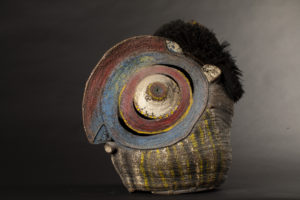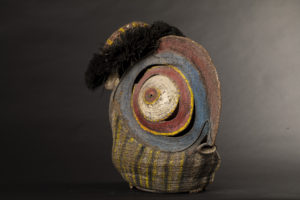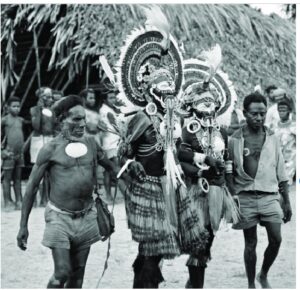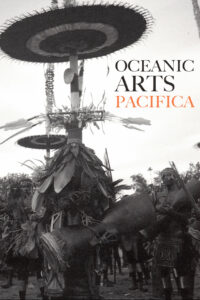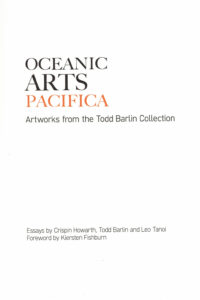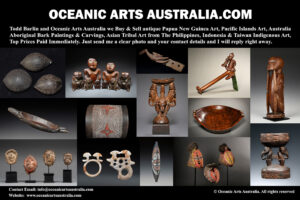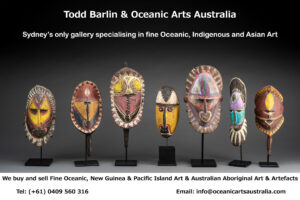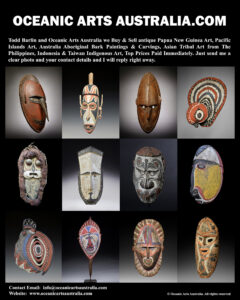A Superb Old New Guinea Woven Baba Mask Abelam People East Sepik River Province Papua New Guinea
| Collection No. | TB-2288 |
|---|---|
| Size | 55cm x 50cm |
This Superb Old New Guinea Woven Mask called baba tagwa is from the Abelam people in the Prince Alexander Mountains Area in the East Sepik Province of Papua New Guinea.
This very fine old example has a great shape, making the face very expressive with the large eyes, small mouth, and feather headdress. The masks are impressive works of sculpture but to the Abelam, their power lies in the bright polychrome ochre paint applied to their surfaces, for the Abelam, paint is a magical substance that endows the figures with supernatural power and beauty.
The Abelam woven basketry masks are made from a type of wild Lygodium vine fibre, the older masks like this example are finer & more tightly woven and you can clearly see that from underneath the mask, the ochre painting is renewed each time the masks are used so they build up a layered smoky patina from and long use and storage.
The Abelam and neighboring peoples of the Prince Alexander Mountains in the Sepik region of northeast New Guinea create several types of basketry masks, they include the type seen here, known in the Abelam language as baba tagwa, which is worn over the head like a helmet, as well as the better-known woven Yam Masks used to decorate the gigantic long ceremonial yams grown and exchanged competitively by Abelam men.
Among the Abelam, baba tagwa masks are associated with the male initiation cycle, in which they are worn by men clad in shaggy costumes made from strips of leaves. During certain ceremonies, these imposing masked figures serve as guards, brandishing lengths of bamboo or other weapons, the baba tagwa drive off women, children, and uninitiated men, who are not permitted to witness the secret initiation rites
Beginning in childhood, each Abelam male must pass through eight separate initiation rites over the course of twenty to thirty years, before he is a fully initiated man. Each successive ritual requires both a physical ordeal and the viewing of increasingly elaborate displays of sacred objects in specially constructed chambers within the men’s ceremonial house. This process continues until the final rites, in which the initiate is shown the largest and most sacred of all displays—the brilliantly painted figures and other images portraying the powerful clan spirits called nggwalndu and ancestor figures.
Provenance: The Elizabeth Pryce Collection Sydney
The Todd Barlin Collection of New Guinea Oceanic Art
I first went to Papua New Guinea in 1985 for an adventure & what I found was that I really enjoyed being with the people of New Guinea, over the next 38 years I spent extensive time spent collecting and documenting traditional art & ceremonies in remote areas of Papua New Guinea & West Papua, The Solomon Islands & Vanuatu & the other Pacific Islands countries. During these travels, I made major collections of New Guinea & Oceanic Art for major Museums and Public Art Galleries
I was honored by being in the prestigious Louvre Museum Magazine for the collections I made for The Museum of African & Oceanic Art Paris in 1996 (now the Musee Quai Branly) for the exhibition “Asmat et Mimika d’ Irian Jaya April 1996 At THE MUSEE NATIONAL des ARTS D’AFRIQUE et d’ OCEANIE, Paris
See my new EXHIBITIONS GALLERY showing the Museums and Art Galleries Exhibitions that I provided artworks for over the past 40 years. There is the link to the article about my artworks published in the prestigious Louvre Magazine in 1996
I have artwork for Museums and art Galleries but also for collectors at every stage of their collecting. I want to encourage people to explore the fine art of New Guinea & West Papua and the Pacific Islands and to be able to see and touch the artworks in a relaxed and friendly manner in my Sydney Gallery. I would like to invite you to visit my gallery and see the artworks in person and also look at my website www.oceanicartsaustralia.com where there are many Galleries & Sub Galleries to explore.
My Gallery of nearly 40 years is the last physical gallery in Sydney that specializes in New Guinea and Oceanic Art. Sydney is very close to New Guinea & the Pacific Islands where all of these amazing artworks came from, Australia’s closest neighbors.
INQUIRE HERE
To see many more rare items and the finest masterpieces, please make an appointment with us to visit the gallery.
For all inquiries, please contact us.

